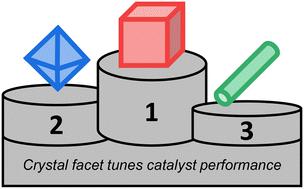当前位置:
X-MOL 学术
›
Catal. Sci. Technol.
›
论文详情
Our official English website, www.x-mol.net, welcomes your feedback! (Note: you will need to create a separate account there.)
Tuning catalytic performance of platinum single atoms by choosing the shape of cerium dioxide supports
Catalysis Science & Technology ( IF 4.4 ) Pub Date : 2024-08-14 , DOI: 10.1039/d4cy00484a Petrus C M Laan 1 , Martijn J Mekkering 1 , Felix J de Zwart 1 , Alessandro Troglia 2 , Roland Bliem 2 , Kai Zhao 3 , Norbert J Geels 1 , Bas de Bruin 1 , Gadi Rothenberg 1 , Joost N H Reek 1 , Ning Yan 1, 3
Catalysis Science & Technology ( IF 4.4 ) Pub Date : 2024-08-14 , DOI: 10.1039/d4cy00484a Petrus C M Laan 1 , Martijn J Mekkering 1 , Felix J de Zwart 1 , Alessandro Troglia 2 , Roland Bliem 2 , Kai Zhao 3 , Norbert J Geels 1 , Bas de Bruin 1 , Gadi Rothenberg 1 , Joost N H Reek 1 , Ning Yan 1, 3
Affiliation

|
The local coordination environment of single atom catalysts (SACs) often determines their catalytic performance. To understand these metal–support interactions, we prepared Pt SACs on cerium dioxide (CeO2) cubes, octahedra and rods, with well-structured exposed crystal facets. The CeO2 crystals were characterized by SEM, TEM, pXRD, and N2 sorption, confirming the shape-selective synthesis, identical bulk structure, and variations in specific surface area, respectively. EPR, XPS, TEM and XANES measurements showed differences in the oxygen vacancy density following the trend rods > octahedra > cubes. AC-HAADF-STEM, XPS and CO-DRIFTS measurements confirmed the presence of only single Pt2+ sites, with different surface platinum surface concentrations. We then compared the performance of the three catalysts in ammonia borane hydrolysis. Precise monitoring of reaction kinetics between 30–80 °C gave Arrhenius plots with hundreds of data points. All plots showed a clear inflection point, the temperature of which (rods > octahedra > cubes) correlates to the energy barrier of ammonia borane diffusion to the Pt sites. These activity differences reflect variations in the – facet dependent – degree of stabilization of intermediates by surface oxygen lone pairs and surface–metal binding strength. Our results show how choosing the right macroscopic support shape can give control over single atom catalysed reactions on the microscopic scale.
中文翻译:

通过选择二氧化铈载体的形状来调节铂单原子的催化性能
单原子催化剂(SAC)的局部配位环境通常决定其催化性能。为了了解这些金属-载体相互作用,我们在二氧化铈 (CeO 2 ) 立方体、八面体和棒上制备了 Pt SAC,并具有结构良好的暴露晶面。通过SEM、TEM、pXRD 和N 2吸附对CeO 2晶体进行了表征,分别证实了择形合成、相同的块体结构和比表面积的变化。 EPR、XPS、TEM 和 XANES 测量显示氧空位密度的差异遵循棒状 > 八面体 > 立方体的趋势。 AC-HAADF-STEM、XPS 和 CO-DRIFTS 测量证实仅存在单个 Pt 2+位点,且具有不同的表面铂表面浓度。然后我们比较了三种催化剂在氨硼烷水解中的性能。对 30-80 °C 之间的反应动力学进行精确监测,得出包含数百个数据点的阿伦尼乌斯图。所有图均显示出明显的拐点,其温度(棒 > 八面体 > 立方体)与氨硼烷扩散到 Pt 位点的能垒相关。这些活性差异反映了表面氧孤对和表面-金属结合强度对中间体的稳定程度的变化(与面相关)。我们的结果表明,选择正确的宏观支撑形状可以如何在微观尺度上控制单原子催化反应。
更新日期:2024-08-14
中文翻译:

通过选择二氧化铈载体的形状来调节铂单原子的催化性能
单原子催化剂(SAC)的局部配位环境通常决定其催化性能。为了了解这些金属-载体相互作用,我们在二氧化铈 (CeO 2 ) 立方体、八面体和棒上制备了 Pt SAC,并具有结构良好的暴露晶面。通过SEM、TEM、pXRD 和N 2吸附对CeO 2晶体进行了表征,分别证实了择形合成、相同的块体结构和比表面积的变化。 EPR、XPS、TEM 和 XANES 测量显示氧空位密度的差异遵循棒状 > 八面体 > 立方体的趋势。 AC-HAADF-STEM、XPS 和 CO-DRIFTS 测量证实仅存在单个 Pt 2+位点,且具有不同的表面铂表面浓度。然后我们比较了三种催化剂在氨硼烷水解中的性能。对 30-80 °C 之间的反应动力学进行精确监测,得出包含数百个数据点的阿伦尼乌斯图。所有图均显示出明显的拐点,其温度(棒 > 八面体 > 立方体)与氨硼烷扩散到 Pt 位点的能垒相关。这些活性差异反映了表面氧孤对和表面-金属结合强度对中间体的稳定程度的变化(与面相关)。我们的结果表明,选择正确的宏观支撑形状可以如何在微观尺度上控制单原子催化反应。





































 京公网安备 11010802027423号
京公网安备 11010802027423号